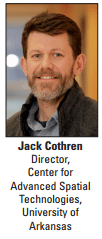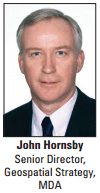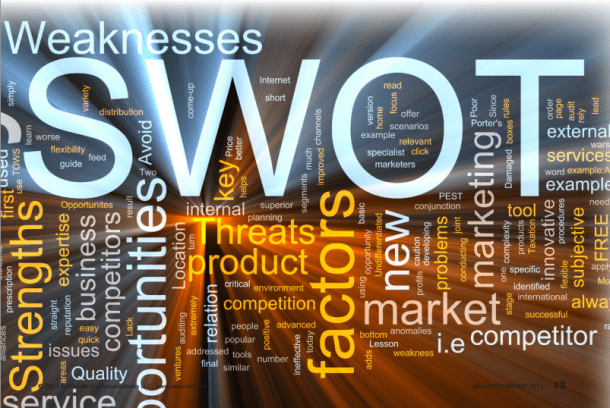In 2008, Earth Imaging Journal asked its Editorial Advisory Board (EAB) members to analyze the remote sensing industry's strengths, weaknesses, opportunities and threats (SWOT). At the time, big players suchas Google and Microsoft were entering the market. The high-resolution imagery market was evolving rapidly, driving numerous geotechnology market segments and often complementing sales of data acquired from aerial platforms. Moreover, innovative sensor technologies in space and aerial systems continued to offer enhanced information capabilities. Considering the fast-paced changes that have occurred during the last five years, we asked our EAB for another SWOT analysis to provide a unique look at the current state of the industry.
 Cothren: If we specifically focus on the changes since 2008, it's clear that in addition to the obvious advantages of superior resolution, the aerial side of the industry has two primary advantages: the availability of light detection and ranging (LiDAR) technology and high-quality oblique images. With the addition of a variety of new sensors and platforms, the satellite side of the industry continues to improve in terms of revisit time, spatial resolution and spectral range, but there's no practical satellite alternative to either aircraft-based LiDAR or oblique imagery. In contrast, the satellite industry obviously has the ability in many circumstances to quickly respond to events across the globe and obtain data in areas that may be difficult to enter.
Cothren: If we specifically focus on the changes since 2008, it's clear that in addition to the obvious advantages of superior resolution, the aerial side of the industry has two primary advantages: the availability of light detection and ranging (LiDAR) technology and high-quality oblique images. With the addition of a variety of new sensors and platforms, the satellite side of the industry continues to improve in terms of revisit time, spatial resolution and spectral range, but there's no practical satellite alternative to either aircraft-based LiDAR or oblique imagery. In contrast, the satellite industry obviously has the ability in many circumstances to quickly respond to events across the globe and obtain data in areas that may be difficult to enter.
 Delay: The satellite photogrammetric capabilities of remote sensing are very mature. Over time the industry has learned how to build manyproducts from imagery data that are used widely within our intelligence community.While the government has invested in commercial providers, the industry as a whole has been investing in new technologies that complement existing capabilities. The rapid increase in motion imagery sources like full-motion video and persistent surveillance, as well as LiDAR and hyperspectral sensors, will increase the value of today's robust capabilities coming from both commercial and Department of Defense (DOD) providers. Key differences among these new sensor classes offer capabilities that complement traditional satellite imagery. In particular, airborne sensors add a real-time aspect to imagery collection, bringing a much different temporal relevance to imagery data when combined with traditional imagery. As the government continues to invest in rapid-response capabilities, we should see an increase in the number of new intelligence products that can be produced by combining traditional satellite imagery with other imagery data types. As we look to the future, the industry needs to do a better job of educating analysts and the community at large of the advantages and disadvantages that multi-intelligence remote sensing systems can bring to the intelligence community.
Delay: The satellite photogrammetric capabilities of remote sensing are very mature. Over time the industry has learned how to build manyproducts from imagery data that are used widely within our intelligence community.While the government has invested in commercial providers, the industry as a whole has been investing in new technologies that complement existing capabilities. The rapid increase in motion imagery sources like full-motion video and persistent surveillance, as well as LiDAR and hyperspectral sensors, will increase the value of today's robust capabilities coming from both commercial and Department of Defense (DOD) providers. Key differences among these new sensor classes offer capabilities that complement traditional satellite imagery. In particular, airborne sensors add a real-time aspect to imagery collection, bringing a much different temporal relevance to imagery data when combined with traditional imagery. As the government continues to invest in rapid-response capabilities, we should see an increase in the number of new intelligence products that can be produced by combining traditional satellite imagery with other imagery data types. As we look to the future, the industry needs to do a better job of educating analysts and the community at large of the advantages and disadvantages that multi-intelligence remote sensing systems can bring to the intelligence community.
 Hornsby: The Earth observation industry has continued to evolve, innovate and grow. Several key strengths that have developed in recent years include increased reliability, revisit, redundancy and imaging capability. This has been achieved through the development of optical and radar satellite constellations, along with global infrastructure improvements that enable rapid data collection and dissemination from most parts of the world.The aerial industry still retains the role of providing the highest resolution imagery compared with satellite sources. Along with street-level imagery, aerial imagery remains the data of choice for navigation and social media uses. The advantage of satellite sources remains the ability to collect data anywhere in the world, across broad regions and at a high frequency without the logistical issues that aerial sources have. The increasing resolution of satellite imagery has closed the gap with aerial data significantly.
Hornsby: The Earth observation industry has continued to evolve, innovate and grow. Several key strengths that have developed in recent years include increased reliability, revisit, redundancy and imaging capability. This has been achieved through the development of optical and radar satellite constellations, along with global infrastructure improvements that enable rapid data collection and dissemination from most parts of the world.The aerial industry still retains the role of providing the highest resolution imagery compared with satellite sources. Along with street-level imagery, aerial imagery remains the data of choice for navigation and social media uses. The advantage of satellite sources remains the ability to collect data anywhere in the world, across broad regions and at a high frequency without the logistical issues that aerial sources have. The increasing resolution of satellite imagery has closed the gap with aerial data significantly.
 Johnson: The industry is highly competent in adhering to standards and developing rigorous models and algorithms to ingest imagery data and develop high-quality, highly accurate and valid products. In the United States and many other countries, government contracts are mainstays for a large number of aerial providers. In the United States, satellite imagery has been certified as meeting the requirements of programs such as the National Agriculture Imagery Program (NAIP), but it remains to be seen whether the collection deadlines can be met. Aerial imagery is viewed as more timely than satellite imagery, because aerial firms can quickly mobilize when the weather is good. This will continue to be an advantage for aerial firms. Aerial companies are developing sensors and systems with rapid product and sometimes on-demand delivery capabilities, which continue to help them maintain their current market share. They're delivering high-accuracy orthoimage maps within hours”even minutes”of a mission, with positional accuracy measured in centimeters. Such imagery can be integrated with different multispectral sensors and LiDAR technology. Advanced aerial sensors like these will continue to open new markets for aerial imagery use, even with the advancing technology of high-resolution commercial satellite imagery. Satellite imagery providers still have the international advantage of seeing the entire planet daily. When difficult-to-image locations on Earth are clear, they can image much faster than an aerial asset can be mobilized. Currently there's a big difference between resolution and accuracy among aerial and satellite data collections. Airplanes collect with direct georeferencing while satellites require ground control points (GCPs). For high-accuracy mapping, aerial imagery providers may still have an advantage over satellite imagery providers once you add in the GCP cost.
Johnson: The industry is highly competent in adhering to standards and developing rigorous models and algorithms to ingest imagery data and develop high-quality, highly accurate and valid products. In the United States and many other countries, government contracts are mainstays for a large number of aerial providers. In the United States, satellite imagery has been certified as meeting the requirements of programs such as the National Agriculture Imagery Program (NAIP), but it remains to be seen whether the collection deadlines can be met. Aerial imagery is viewed as more timely than satellite imagery, because aerial firms can quickly mobilize when the weather is good. This will continue to be an advantage for aerial firms. Aerial companies are developing sensors and systems with rapid product and sometimes on-demand delivery capabilities, which continue to help them maintain their current market share. They're delivering high-accuracy orthoimage maps within hours”even minutes”of a mission, with positional accuracy measured in centimeters. Such imagery can be integrated with different multispectral sensors and LiDAR technology. Advanced aerial sensors like these will continue to open new markets for aerial imagery use, even with the advancing technology of high-resolution commercial satellite imagery. Satellite imagery providers still have the international advantage of seeing the entire planet daily. When difficult-to-image locations on Earth are clear, they can image much faster than an aerial asset can be mobilized. Currently there's a big difference between resolution and accuracy among aerial and satellite data collections. Airplanes collect with direct georeferencing while satellites require ground control points (GCPs). For high-accuracy mapping, aerial imagery providers may still have an advantage over satellite imagery providers once you add in the GCP cost.
 Philp: The remote sensing industry, a technology-intensive industry by definition, does well in driving the science and technology of developing,deploying and using increasingly sophisticated sensor systems that produce a staggering array of valuable data products. The recent explosion in airborne LiDAR products is a good example. Today's airborne-based systems can provide increasingly high-resolution imagery products for smaller areas”especially valuable for asset mapping and infrastructure management. In addition, cloud-penetrating airborne systems continue to provide an advantage in terms of the cloud-cover problem.
Philp: The remote sensing industry, a technology-intensive industry by definition, does well in driving the science and technology of developing,deploying and using increasingly sophisticated sensor systems that produce a staggering array of valuable data products. The recent explosion in airborne LiDAR products is a good example. Today's airborne-based systems can provide increasingly high-resolution imagery products for smaller areas”especially valuable for asset mapping and infrastructure management. In addition, cloud-penetrating airborne systems continue to provide an advantage in terms of the cloud-cover problem.
 Raber: One thing you can always count on in our rapidly progressing remote sensing profession is that change is constantly occurring and is almost inevitable. Although change can be considered a challenging aspect with continuous investments in technology, training and workflowdevelopment, I believe that change is a positive for the profession because it plays a major role in retaining bright employees, attracting young andnew talent to our field, providing exciting careers, and ultimately allowing curious minds to create innovative solutions and technologies that solvereal-world challenges.Let's face it: Remote sensing and geospatial jobs are really cool. Just look at the eyes of a nontechnical person when you tell them what you do for a living. A visible result of our ability to adapt and change has created a sustainable profession that continues to be mentioned in theDepartment of Labor statistics as a growing and desirable profession. Most of us have relatively high-paying, high-tech jobs that typically provide high personal value to practitioners. In the future, these are the types of satisfying careers the U.S. economy must continue to produce and maintain as the information society and knowledge-based economy evolves. Embracing and leveraging change also lies at the source of personal and professional growth in our community.Another significant strength of our profession is all the people who dedicate their careers to serve society and offer their make-a-difference attitude. There are countless professionals making a positive impact using their knowledge and technology to yield quality-of-life-changing results. Making the world a better, safer, more efficient, cleaner and healthier place, remote sensing practitioners use their spatial acumen to do great things for others in their daily careers or on a volunteer basis through various outreach programs. One example of this is GIS Corps,which is sponsored by the Urban and Regional Information Systems Association. GIS Corps' mission is to coordinate short-term, volunteer-based geographic information system (GIS) services to underprivileged communities and respond in emergency situations.
Raber: One thing you can always count on in our rapidly progressing remote sensing profession is that change is constantly occurring and is almost inevitable. Although change can be considered a challenging aspect with continuous investments in technology, training and workflowdevelopment, I believe that change is a positive for the profession because it plays a major role in retaining bright employees, attracting young andnew talent to our field, providing exciting careers, and ultimately allowing curious minds to create innovative solutions and technologies that solvereal-world challenges.Let's face it: Remote sensing and geospatial jobs are really cool. Just look at the eyes of a nontechnical person when you tell them what you do for a living. A visible result of our ability to adapt and change has created a sustainable profession that continues to be mentioned in theDepartment of Labor statistics as a growing and desirable profession. Most of us have relatively high-paying, high-tech jobs that typically provide high personal value to practitioners. In the future, these are the types of satisfying careers the U.S. economy must continue to produce and maintain as the information society and knowledge-based economy evolves. Embracing and leveraging change also lies at the source of personal and professional growth in our community.Another significant strength of our profession is all the people who dedicate their careers to serve society and offer their make-a-difference attitude. There are countless professionals making a positive impact using their knowledge and technology to yield quality-of-life-changing results. Making the world a better, safer, more efficient, cleaner and healthier place, remote sensing practitioners use their spatial acumen to do great things for others in their daily careers or on a volunteer basis through various outreach programs. One example of this is GIS Corps,which is sponsored by the Urban and Regional Information Systems Association. GIS Corps' mission is to coordinate short-term, volunteer-based geographic information system (GIS) services to underprivileged communities and respond in emergency situations.
 Stojic: In its most fundamental form, imagery serves as a treasure chest that allows us to reveal information about Earth at any given time. Essentially, our industry provides the data and tools that record and track changes to our planet. The information derived from the data can help predict future changes, shape policies and laws, and provide insight to make smarter decisions. Aerial imagery allows us to be more agile when it comes to understanding change, providing data to an ecosystem of organizations that needs data quickly. Because the data come from airborne devices, which can be configured to support various mapping needs via aircraft and unmanned aircraft systems (UASs), it's easier to get diverse, high-resolution content”ranging from optical, radar, hyperspectral and LiDAR data”in one payload. Satellite imagery provides content across broad regions and the ability to revisit areas frequently for change-detection purposes. Satellite imagery also brings great spectral depth to a pixel, which allows organizations to dive deeper in terms of analytics.
Stojic: In its most fundamental form, imagery serves as a treasure chest that allows us to reveal information about Earth at any given time. Essentially, our industry provides the data and tools that record and track changes to our planet. The information derived from the data can help predict future changes, shape policies and laws, and provide insight to make smarter decisions. Aerial imagery allows us to be more agile when it comes to understanding change, providing data to an ecosystem of organizations that needs data quickly. Because the data come from airborne devices, which can be configured to support various mapping needs via aircraft and unmanned aircraft systems (UASs), it's easier to get diverse, high-resolution content”ranging from optical, radar, hyperspectral and LiDAR data”in one payload. Satellite imagery provides content across broad regions and the ability to revisit areas frequently for change-detection purposes. Satellite imagery also brings great spectral depth to a pixel, which allows organizations to dive deeper in terms of analytics.WEAKNESSES
What can the remote sensing industry do better? What are some common complaints?
Cothren: The academic community does a reasonable job of training remote sensing specialists, but we still lag in our ability to create an educated consumer of remotely sensed products. By this I mean individuals who are primarily focused on geospatial applications, such as GIS, but who have an important need for data sets derived from remotely sensed sources.
Delay: There are a lot of imagery collection capabilities across the DOD and intelligence communities; unfortunately, they aren't very well coordinated from a collection perspective. This problem will continue to be an issue as long as the industry doesn't embrace open standards, which lead to easy data discovery and make data more accessible across the community. Today, this problem is propagated by the fact that each data type is managed and exploited within separate archives and personal electronic delivery systems. This also leads to a lot of duplicate data that must be stored and distributed across already challenged network infrastructures. As new sensor classes continue to improve, they'll provide complementary capabilities to overcome challenges with bad weather, foliage and other collection challenges. However, if the new data types aren't easily discovered, then investments in new capabilities won't lead to optimal solutions.
Hornsby: One of the fundamental challenges the industry continues to have is the need to clearly demonstrate value propositions that support the use of Earth observation data and derived products. There has been progress in this area, so now we see the routine use of Earth observation data to support operational needs around the world. Examples include providing critical information to support ship navigation, maritime domain awareness and mine hazard monitoring. One thing that will help solve the value-proposition challenge is to have exploitation tools that meet specific user needs. This is a common complaint and is a barrier to broader utilization by users who don't know much about Earth observation data and data processing. Mission and system interoperability is another area that needs to improve. This isn't a trivial challenge to overcome, given that Earth observation systems are developed by different companies and organizations around the world with different priorities and operating policies. Lack of interoperability makes it more difficult for users to generate the greatest value from Earth observation data and therefore is a limiting factor in overall market growth, despite significant growth resulting from the development of constellation missions.
Johnson: We need to serve the client base with products that are user friendly and delivered in more timely ways. We also need to expand the types of markets that can be reached with imagery-based products that aren't meant for expert users. Imagery data are too difficult to find, ingest and develop products from”you still need an expert to manage imagery. Also, U.S. data and service providers must determine how they will invest in technology improvements for product development and delivery and capture some of the larger global geospatial market share. The location-based services market is predicted to grow to $20 billion by 2015. This remote sensing industry center of gravity seems to be shifting outside the United States to countries where governments and large commercial corporations are making large and long-term investments in multiple and advanced sensors. In the long term (5-10 years), the U.S.-based satellite and aerial imagery providers may have shrinking growth rates”a very different position than where they've been in the past. The downstream impact may be significant, as imagery production continues to grow in countries outside the United States and affects U.S. value-added service providers.
Philp: The remote sensing industry, which is a diverse industry with many players and significant public- and private-sector missions, must continue to shorten the cycle from requirement to data product delivery; it takes too long to go from capture to delivery. In addition, like many trends in the geospatial marketplace, I have yet to see any of the major players in the collection side of the equation”airborne or satellite”develop a pixel as a service business model. This can be extended to image as a service and, finally, to image analytics as a service. To be relevant in the coming years, with increasing government reductions in spending at the local, state and federal level, content creators need to deliver on-demand, value-added solutions, not just data products, to consumer agents in a cost-effective, cloud model”pay for the imagery and related products based upon use. Just as the standard software licensing model is being significantly challenged, so is the idea of licensing a bunch of image files, storing them 20 times redundantly across a state organization or enterprise and using maybe 20 percent ofthe value of a 4-band image. Sooner or later someone is going to demand return on investment and total cost of ownership for millions of.geotiffs that no one really uses”get your base imagery for free from Google, Microsoft, Esri or others who already have commoditized pixels. This side of the industry, associated with the inherent cost, must change if the industry is going to thrive.
Raber: Being active in the political process hasn't been a strength of our profession. However, with the many decisions being made in Washington, D.C., I advocate that now is the time for individuals and firms to trust in the democratic process and get involved. I visualize following the various legislation that impacts my geospatial business similar to how I track my 401K investment. There are currently numerous bills making their way through the political process that will influence federal/local geospatial spending, reduce duplication and waste, and create land inventory management practices that can have long-lasting impacts to those practicing in this profession. A few of these geospatial reform bills are the Federal Land Asset Inventory Reform (FLAIR ) Act and the Map It Once Use It Many Times Act. For the first time in our profession, we have an opportunity to be part of creating the solutions to many of the issues that could stimulate growth within our profession. In the long run, by being actively involved in the political process, geospatial professionals could ultimately turn this weakness into a strength.
Stojic: We need to demystify geospatial data and clearly articulate the value, benefits and the cost-effective approach required to derive information. For far too long, geospatial systems have been cumbersome, at times requiring someone with an advanced degree to decipher the data for an organization. As a whole, we haven't been able to break down the complexity of geospatial data and bring such date to the masses in an effective and cost-efficient way so the information can be used. In addition, the geospatial information lifecycle is far too long. By the time data come off a sensor and reach the desktop as relevant information, weeks or even months may have passed. At this point, it may be too late for some organizations to make timely decisions, making the data less important.
Now it's time for U.S. remote sensing and geospatial firms to also participate. One organization addressing the international business opportunity is MAPPS, the association of private geospatial firms. In November 2013, MAPPS, with participation from several related associations and organizations, will sponsor an international market conference in the Washington, D.C., suburb of Alexandria, Va. The conference is intended to educate and excite U.S. firms by providing a practical overview of the international market from public- and private-sector speakers. Another opportunity for the global remote sensing market is the pending GeoEye/DigitalGlobe merger. Combining these two world-class satellite companies will ultimately create a single U.S. firm that could re-establish the United States as the leader in remote sensing and outperform any of the international competition. Working for a company that competes and represents both DigitalGlobe and GeoEye in the international marketplace, I feel a unified front from the blended companies will once again put American innovation in the forefront of our profession, thus allowing more opportunities to resell imagery products and to derive unique remote sensing analytics and value-added services from the highest resolution satellites available.
Philp: One of the more significant threats to the industry is the U.S. economy's unresolved economic condition and how it impacts domestic and global behavior. One way or the other, there will be significant reductions in available federal dollars, and this will impact the industry. The National Geospatial-Intelligence Agency's recent declarations and statements reflect the fact that the U.S. government can't afford to help subsidize two primary entities and is driving consolidation through merger and acquisition. It will be interesting to see how this plays out on Wall Street, where private capital is playing a key role in the industry. In addition, as stated previously, there's an increasing and growing expectation that imagery should be free based on the sea-change that has occurred with Google and Microsoft providing base-imagery services for free as part of their advertising models. This is compounded by the fact that as more people enjoy imagery as a consumable, mass-consumer experience with geo-enabled mobile platforms, it's becoming difficult to understand the cost-to-benefit ratio of imagery-derived solutions. So, as discussed before, these threats should be a significant wake-up call for the industry to immediately shift to selling solutions and grow the value chain proposition to justify the market. Although many in the industry have tried to achieve this objective, the industry needs to leapfrog itself and go directly to affordable series of analytical services that leverage a combination of data and modeling as a service to deliver affordable answers vs. static licenses. I'd focus less on sensor and sensor systems and get a business model that works by selling solution services that are consumed and integrated by the largest commercial industries in the world”consolidate, innovate and add value against well-funded business problems that entail extracting intelligence from pixels.
Raber: There's a delicate balance of what the private geospatial sector can offer and what the government capabilities are. As such, I believe a major threat to private remote sensing and geospatial firms is government insourcing. There's no hiding the fact that the U.S. government has grown in staff in recent years, while many private firms have reduced staff. Additionally, there are instances where projects that could have been completed by private-sector firms were completed by internal government resources. If the economy is going to rebound and technology innovations are going to continue to occur, the private sector and government must behave as partners, not as competitors. Creating a consistent flow of publically funded projects by the government, the private sector will produce higher quality and innovative solutions while maintaining competitive rates.These ideas aren't new and in no way meant to eliminate government involvement. Instead, if each entity could focus on its strengths”government focusing its expertise on technical standards and specifications, collaborative funding, eliminating redundancy, and improving procurement practices while leaving commercially available acquisition, production and value-added services to the private sector”one of many possible positive outcomes is more effective delivery of more and better data products and services. Conversely, possible negative outcomes could impact both entities by slowing innovation, limiting professional growth and possibly reducing staff due to ineffective use of public funds.
Stojic: Unfortunately, I think we may have missed an opening to educate the world about the value of geospatial systems. Google created a fantastic opportunity for the industry when it started allowing the world to see imagery of houses, neighborhoods and cities. Since that time, we haven't made more powerful geospatial tools ubiquitous, engaging the masses or at least bringing together industries that could truly benefit from the power of geography. The other threat is our inability to diversify beyond the defense and national mapping sector. For a long time, we've focused on defense and intelligence solutions, and the industry hasn't been as proactive in identifying equally valued opportunities in adjacent and vertical markets.


